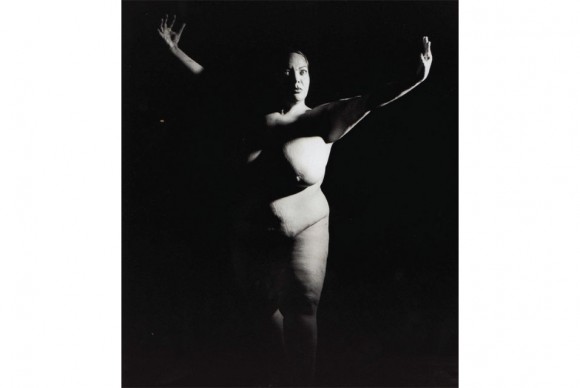Exhibition seeks to explore the way artists have addressed female body image in contemporary art
March 10, 2014 by All Art News
Filed under Photography
OLD WESTBURY, NY.- The Amelie A. Wallace Gallery at SUNY College at Old Westbury is presenting Body Conscious, a group exhibition by nine internationally acclaimed artists with diverse and exciting practices. Body Conscious seeks to explore the way artists have addressed female body image in contemporary art. By tackling anorexia, dieting, obesity, etc., each of these artists attempts to articulate the Western obsession with the size of women’s body. According to the National Eating Disorders Association, over 20 million women suffer from significant eating disorders. Today, girls as young as six years old are starting to express concerns about their weight. This focus on the female body needs to shift. In this instance, the artists in this exhibition attempt to complicate the idea of “normal,” demonstrating the idea of beautiful in the various sizes of body types. However, they also show the intense side effects and the destructive capabilities that eating disorders and body manipulation can have on the female body. Hopefully, by showing these artworks together, the conversation concerning female body size can shift its focus from judging women based on the size of their body to judging the way that media and society often criticizes the female form.
Included Artists:
Laia Abril (b. 1986, Barcelona, splits time between Barcelona and Treviso, Italy) uses documentary photography to draw attention to problematic pursuits of extreme body image, particularly eating disorders. Drawing on her own experiences, Abril has created a three-part project that seeks to create empathy with those who suffer from the disorder, while acknowledging the ways the disease can be perpetuated. Both A Bad Day (2011) and Thinspiration (2012), consider the multiple ways that anorexia and bulimia can infiltrate the lives of young women.
Beth B (b. 1955, New York) critiques the way that society has both perceived and perpetuated the ideal form. Trophies is a series of work that tackle mutations and mutilations of the female physique. Not only does she explore anorexia, she depicts the dramatic way that corsets can actually alter the female body through sculptural representation. Additionally, her film Exposed (2014) examines the way that the nude body can be utilized effectively by various artists to make necessary social statements.
Maureen Connor (b. 1947, New York) challenges traditional views of women by questioning society’s depictions of body size, gender, and age throughout her career. Thinner than You (1990) epitomizes this exploration, as she places an impossibly thin, black dress on a pole vaguely resembling the human form. This piece, along with others that utilize the stretching and pulling of lingerie fabric, encourages the viewer to consider the impossible standards set for women’s appearance.
Katya Grokhovsky (b. 1977, Ukranian born, Australian raised, New York based) uses performance to challenge identity and gender constructions. Her 2013 collages express the visceral experiences of the body including vomiting, swelling of the body, and the feeling of flesh. Her performance, One Fine Day (2013) utilizes textual descriptions of her body to encourage the often shameful and derisive ways that female bodies are discussed.
Ariane Lopez-Huici (b. 1945, Biarritz, France, splits time between New York and Paris) focuses on the physical body. However, Lopez-Huici often relies upon the unexpected or transgressive, choosing subjects who are not the typical “ideal” of beauty. In that vein, her series of photographs on Aviva and Dalila focus on the flesh of their large bodies, while still highlighting their beauty and power. These ideas are further explored in Rebelles, a series of group shots, focusing on similarly fat bodies posed in ways that reinforce their shape while simultaneously expressing joy and sisterhood.
L.A. Raeven (b. 1971, Amsterdam) challenge the fashion industry and pressures placed on women with their work, while often seeming complicit in perpetuating the heralding of the thin woman. Producing work together, twins Liesbeth and Angelique Raeven began their project Ideal Individual (1999-2001) with the publication of an advertisement that called for women who were extraordinarily thin, essentially prepubescent. As the women came for a casting call, they were all told they were not chosen for the program, emphasizing the constant feelings of inadequacy experienced by many women towards their bodies.
Faith Ringgold (b. 1930, New York) often addresses social justice throughout her work, and similarly, Change 2: Faith Ringgold’s Over 100 Pound Weight Loss Performance Story Quilt, 1988 (1988) while incorporating personal concerns. After Ringgold lost one hundred pounds, she embarked on a series of quilts exploring her feelings regarding her health and her body. Using anecdotes and personal photographs, this series may address Ringgold’s personal struggle with food but are easily relatable to the viewer.
Martha Rosler (b. 1943, New York) makes conceptual art that often causes the viewer to reconsider their own experiences. In one of her earlier videos, Losing: A Conversation with the Parents (1977), she explores the tragedy of anorexia from the perspective of the parents who have lost their daughter to the disease. Just over eighteen minutes, the film recalls the confessional nature of talk shows that were becoming increasingly prevalent throughout the 1970s.
Ivonne Thein (b. 1979, Berlin) creates work that often engages the priority placed on women’s appearances. Her series Thirty-Two Kilos (2008) recalls the extreme bodies that appear in fashion magazines: through considerable use of computer manipulation, she modified photographs of already thin women by making them even smaller. The women are posed to recall models’ awkward positioning, while wearing very little clothing, which is, in fact, mostly bandages potentially referencing the medicalization of female bodies.

